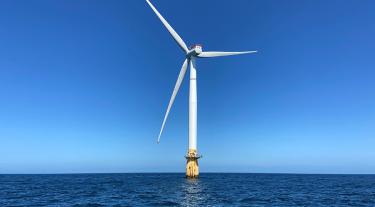These findings, released by the Floating Wind Joint Industry Programme (Floating Wind JIP), are part of the Stage 2 Phase 4 Summary Report, which provides a high-level overview of four key research projects delivered between 2020 and 2022.
The Floating Wind JIP is the Carbon Trust’s collaborative R&D programme, dedicated to overcoming technological challenges and advancing commercialisation of floating offshore wind. The programme is a partnership between the Carbon Trust and 17 offshore wind developers.
With numerous commercial scale floating wind farms planned, but limited operational data due to the relative infancy of floating wind compared to its fixed bottom counterparts, the industry needs more information. The research covers:
- Floating wind access and availability
- An assessment of wind turbine generators for floating wind
- Numerical modelling guidelines and standards for floating wind
- An assessment of floating wind turbines’ impact on yield.
Research on floating wind access and availability analysed how different access methods and floating platform types affected turbine availability, and the effects of floating platform motions on technicians. For a hypothetical minor repair, it found floating wind strategies were likely to be similar to those for fixed-bottom far-shore sites and that floating turbine nacelle motions were not expected to be a significant problem with respect to motion-induced sea sickness.
To-date floating wind projects have generally used wind turbine generators designed for fixed bottom applications. Greater understanding is needed regarding deployment and design adjustments to maximise yield and ensure turbines are optimised throughout the entire floating wind farm life cycle. The assessment of wind turbine generators for floating wind farms project focused on understanding the differences in the load/motion envelope when moving from a fixed-bottom monopile to a floating foundation and the feasibility of delivering cost-effective soft-stiff designs.
This was followed by the numerical modelling guidelines project, which provided guidance for selecting and using numerical modelling tools for floating turbine design and detailed recommended load cases to reduce simulation efforts. For optimal integrated modelling, wind turbine and floater designers should clarify how they will work together to couple software at the start of a project.
Finally, with limited operational performance data available, the impact of floating wind turbines on yield is not yet well understood or quantified. Through this project, key floating wind effects were taken into consideration to ultimately try to understand, quantify and bound the impact of floater motions on wake effects and energy yield. Through key stakeholder engagement, a number of recommended practices for developers, foundation suppliers, turbine OEMs and tool venders were established and included within this report.
The release of the Summary Report coincides with the announcement that all 17 participants of Floating Wind JIP: bp, EDF Renouvables, EnBW, Equinor, Kyuden Mirai Energy, Ørsted, Ocean Winds, Parkwind, RWE Renewables, ScottishPower Renewables, Shell, SSE Renewables, TEPCO, Tohoku Electric Power Company, Total Energies, Vattenfall, and Wpd. will be continuing into Stage 3, which will run from 2022 to 2026.
Stage 1 of the programme, delivered in 2016 focused on initial feasibility of floating offshore wind. Stage 2, from 2017 to 2022, focused on overcoming technology challenges and identifying opportunities. Stage 3 will continue to focus on overcoming technological challenges and developing solutions which support the deployment of floating wind at a global industrial scale.
Tender opportunities for projects delivered as part of Stage 3 Phase 1 will be announced later this year. Companies who would like to receive notifications can register their interest here.
Sam Strivens, Head of Floating Offshore Wind at the Carbon Trust said:
“The past twelve months have seen a vast increase in floating wind activity. National targets were set at 6GW for the west coast of the United States and raised to 5GW by 2030 in the UK. Meanwhile floating specific tenders were underway in France, and pipeline projects were increased across Asia, totalling at least 25GW by 2035. The next challenge facing the floating offshore wind sector will be meeting this industrial demand. Collaboration, between regulators, windfarm developers and supply chain will be crucial to accelerate the commercial deployment of floating offshore wind and achieve Net Zero targets.”
Read the Phase IV summary report
ENDS
Notes to editors
For further information please contact: The Carbon Trust press office on +44 (0)20 7170 7050 or press@carbontrust.com.
About the Carbon Trust
The Carbon Trust is a global climate consultancy driven by the mission to accelerate the move to a decarbonised future. We have been pioneering decarbonisation for more than 20 years for businesses, governments, and organisations. Drawing on a network of over 300 experts internationally, the Carbon Trust guides organisations through their journey to Net Zero. From strategic planning and target setting to delivery, activation, and communication - we provide smarter ways to turn intent into impact.
About the Floating Wind Joint Industry Programme
The Floating Wind Joint Industry Programme is a world leading collaborative research and development (R&D) initiative that aims to overcome technological challenges and advance commercialisation of floating offshore wind.
Image credit: Alistair Morris


